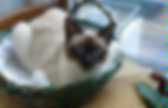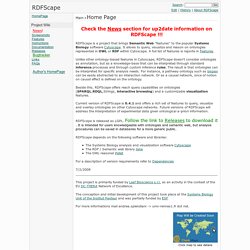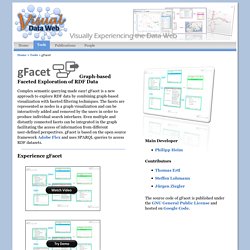

POD - Product Open Data -
Semantic Universe. RDFScape : Home Page. RDFScape is a project that brings Semantic Web "features" to the popular Systems Biology software Cytoscape.

It allows to query, visualize and reason on ontologies represented in OWL or RDF within Cytoscape. A full list of features is reporte in Features. Unlike other ontology-based features in Cytoscape, RDFScape doesn't consider ontologies as annotation, but as a knowledge-base that can be interpreted through standard inference processes and through custom inference rules. The result is that ontologies can be interpreted for specific analysis needs. For instance, a pathway ontology such as biopax can be easily abstracted to an interaction network. Sparql-browser - Standalone SPARQL Query Browser. RelFinder - Visual Data Web. Are you interested in how things are related with each other?

The RelFinder helps to get an overview: It extracts and visualizes relationships between given objects in RDF data and makes these relationships interactively explorable. Highlighting and filtering features support visual analysis both on a global and detailed level. The RelFinder is based on the open source framework Adobe Flex, easy-to-use and works with any RDF dataset that provides standardized SPARQL access. Check out the following links for some examples: The RelFinder can easily be configured to work with different RDF datasets. The RelFinder can also be more deeply integrated with your project: Integrating the RelFinder See the following examples of how the RelFinder is integrated into other projects: Ontotext applies the RelFinder to enable an exploration of relationships in the biomedical domain. All tools on this website are research prototypes that might contain errors. DERI Pipes.
gFacet - Visual Data Web. Complex semantic querying made easy!

gFacet is a new approach to explore RDF data by combining graph-based visualization with faceted filtering techniques. The facets are represented as nodes in a graph visualization and can be interactively added and removed by the users in order to produce individual search interfaces. Even multiple and distantly connected facets can be integrated in the graph facilitating the access of information from different user-defined perspectives. gFacet is based on the open source framework Adobe Flex and uses SPARQL queries to access RDF datasets. gFacet is readily configured to access data from the LOD cloud and only requires a Flash Player plugin to be executed (which is usually already installed in web browsers).
All tools on this website are research prototypes that might contain errors. Read more about gFacet and the idea of graph-based faceted exploration in the following publications: Tabulator: Generic data browser. The Tabulator project is a generic data browser and editor.

Using outline and table modes, it provides a way to browse RDF data on the web. RDF is the standard for inter-application data exchange. You can use it in two ways As a Firefox Add-on The tabulator extension is a Firefox extension which allows Firefox to handle data as well as documents. As a web application The tabulator online version is a set of open source Javascript scripts ("AJAX") which can run in any web page to add data browsing. The Tabulator is open source under the W3C software license. Try it: KIM Platform. DAML.org. Piggy Bank. Piggy Bank Contributing Piggy Bank is an open source software and built around the spirit of open participation and collaboration.

There are several ways you can help: Blog about Piggy Bank Subscribe to our mailing lists to show your interest and give us feedback Report problems and ask for new features through our issue tracking system (but take a look at our todo list first) Send us patches or fixes to the code Publish Semantic Web data on your web site (how-to) for Piggy Bank’s consumption Write and submit new screen scrapers for others to use. Swoop - Semantic Web Ontology Editor. FUSION Semantic Registry. UDDI-based Web service registries are included as a standard offering within the product suite of all major SOA vendors, serving as the foundation for establishing design-time and run-time SOA governance.
Despite the success of the UDDI specification and its rapid uptake by the industry, the capabilities of its offered service discovery facilities are rather limited. The lack of machine-understandable semantics in the technical specifications and classification schemes that are used for retrieving services prevent UDDI registries from supporting fully automated and thus truly effective service discovery. The FUSION Semantic Registry is a semantically-enhanced service registry that builds on the UDDI specification and augments its service publication and discovery facilities to overcome these limitations. Swoogle Semantic Web Search Engine.
Triplify — Agile Knowledge Management and Semantic Web (AKSW) More than 20 European Union Datasets Converted to RDF by LATC Project Over the past two years, the LATC project (Linked Open Data Around-The-Clock) has worked on converting more than 20 EU datasets to RDF, make them available as Linked Data and SPARQL, and link them to other datasets.

The datasets have gone through internal quality assurance against a publication checklist. Read more about "More than 20 European Union Datasets Converted to RDF by LATC Project" May 4-5: Leipziger Semantic Web Tag 2011 and Local Media Conferenz Like in the past two years, we again organize a Leipzig Semantic Web Day on May 5th at the marvelous Mediencampus Villa Ida. Triplification Challenge Winners Today we announced the winners of this year’s Triplification Challenge, which have been selected from 23 submissions.
Semantic-mediawiki.org. Pellet: OWL 2 Reasoner for Java. Apache Jena - Apache Jena. LanguageWare Resource Workbench. Update: July 20, 2012: Studio 3.0 is out and it is officially bundled with ICA 3.0. If you are a Studio 3.0 user, please use ICA forum instead of LRW forum. 7.2.0.2 LRW is a fixpack that resolves issues in various areas including the Parsing Rules editor, PEAR file export and Japanese/Chinese language support. 7.2.0.1 LRW is still available for download on the Downloads link for IBM OmniFind Enterprise Edition V9.1 Fix Pack users. What is IBM LanguageWare? IBM LanguageWare is a technology which provides a full range of text analysis functions.
It is used extensively throughout the IBM product suite and is successfully deployed in solutions which focus on mining facts from large repositories of text. LanguageWare is the ideal solution for extracting the value locked up in unstructured text information and exposing it to business applications. It comprises Java libraries with a large set of features and the linguistic resources that supplement them. How does it work? More information FAQs. The Protégé Ontology Editor and Knowledge Acquisition System. Apache UIMA - Apache UIMA.